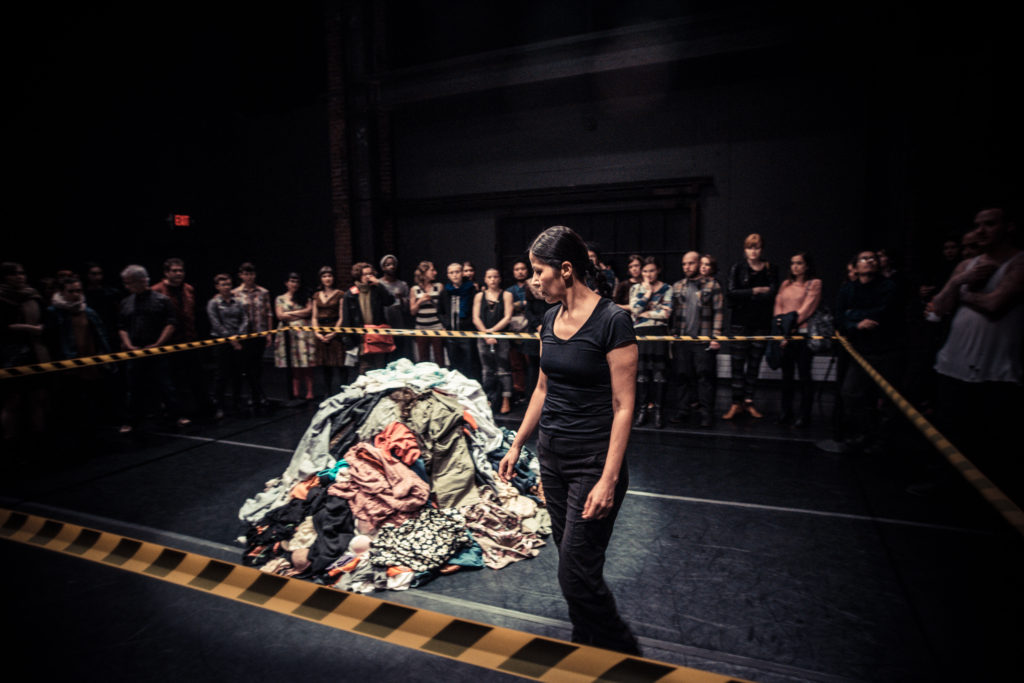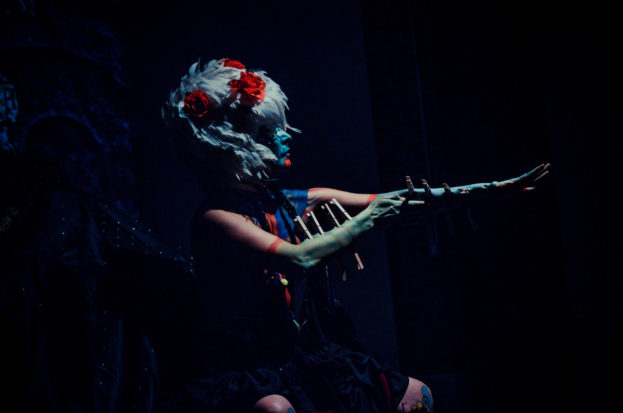FRESH Festival. Photo by Robbie Sweeny.
“We were thinking about a number of other things,” says Roberto Varea when I ask him about what he and collaborator Violeta Luna have planned for their FRESH Festival outing this month. “…and then the earthquake occurred on November 8th and we started rethinking.”
Varea and Luna are seated on opposite sides of a wooden table in an old-guard Mission District café, accompanied by a loud soundtrack—Dylan live, Bob Marley’s No Woman No Cry… We lean in to hear one another better, which heightens the conspiratorial mood. The presidential election is only a few weeks old and there’s a sense of dread that hangs in the air, of people bracing themselves for the coming storm.
“Going back to this empathy/disruption thematic thread for FRESH ’17,” continues Varea, referring to the too-timely prompt from the Festival’s 2017 curators (including founder Kathleen Hermesdorf, Abby Crain and José Navarrete), “…it felt like the time was ripe to try to imagine a new work dealing particularly with what’s going on, in the context of empathy for immigrants.”
The title for the new piece, sanct·u·are / (sanc·tu·ar·y), turns on the status of San Francisco as a sanctuary city for all (including undocumented) immigrants as well as the temporary zone of acceptance (safety “for the expression of the unsafe”) manifest in socially engaged performance. Varea is directing and supplying video to the concept that he and Luna are evolving. In addition to performing the piece, Luna supplies costumes and properties. Music and sounds will be furnished by David Molina, a longtime collaborator and, like Luna and Varea, an immigrant himself.
“That’s the spin on the word sanctuary,” continues Varea. “Hopefully it will be obvious enough for people to conjure the idea of the sanctity of the other— especially the most vulnerable other, in the context of immigration and the climate that Trump and Sessions and all these people are going to be putting into practice for them. Let alone the reality of an immigrant that 99 times out of 100 is not leaving to ‘make it’ in some other place but because of some catastrophic situation back home.”
Violeta Luna, leaning into the conversation, expands on the title, sometimes softly passing through a phrase in Spanish before reaching for an English equivalent in her pronounced Mexico City accent.
“I mean a place where you can have dialogues with different people who come from different backgrounds in terms of ethnicity, gender, disciplines—you can create a space of security where you can talk to different forms, to approach themes in different ways. For example, I am an immigrant, I am a woman, but also I am Mexican. All of the narratives [placed on me by] power, I can speak [to] in a safe space.”
Deeply invested in the bifurcated, in between identity of the immigrant and of all forms of otherness, Luna has long worked at the intersection of ritual, installation, performance art and theater, both in solo projects and in collaborations, including La Pocha Nostra. Her work has been presented in the Bay Area for the last two decades, but about ten years ago she established a permanent residence here. A couple of years later she began working with Argentine-born theater director and University of San Francisco professor Varea and Salvadoran-born musician-composer Molina in the collective Secos y Mojados (which also included visual artist Victor D. Cartagena).
sanct·u·are / (sanc·tu·ar·y) builds on this and related work, including Secos y Mojados’ Border TRIP(tych) (2008), a rigorous exploration of the immigrant experience at the site of the divided, besieged, remembering, anguished, desiring body itself. The task, made increasingly urgent in a time of unbridled authoritarianism and scapegoating, remains to humanize the other.
In a highly unequal system, the marginalized and criminalized immigrant is a vulnerable body that can be easily manipulated by the powerful actors at the top, who have multiple uses for it, beginning as cheap labor but extending to a political cipher that can be deployed as a convenient stereotype by demagogues, as the recent election demonstrated so appallingly well.
Art as sanctuary, then, means the space for re-appropriating, re-writing, complicating, questioning those narratives put on us by the dominant forces in society?
Violeta Luna: Yes, though it’s hard to keep those spaces. And not just here, but all over the world, people are having to work harder to [maintain an artistic practice] in terms of securing a budget, getting grants…
Roberto Varea: To me it is one of the most horrible hypocrisies of our culture, that of picking on the most vulnerable of scapegoats because they don’t speak the language [and overlooking the fact that they are] most likely leaving conditions unfavorable to them, because they are favorable to us in the U.S…. Controlling people involves also oiling the machinery of their exploitation, particularly those without papers, who they’re counting on being here anyway. There’s this overwhelming construction of the Evil Other and the Righteous Self, and then there’s the actual economy.
How do you begin to approach this terrain again, in an aesthetic sense? What does your process look like?
RV: That’s the big question for us too! We shift gears a lot as we’re thinking about a number of things. Of course, the good thing about it is that FRESH invites us to start something new. But we’re certainly going to build on a number of things.
VL: For me, it’s important to approach it at different levels. First there is all the research that we need to do and that we have already done, and also our own personal history. But also this level that is more intuitive. My work is more performance art in that sense. Objects [are] also very important. A suitcase. A pair of shoes. Clothes given us by a friend, an undocumented worker—clothes that he was wearing when he crossed the border.
RV: We’re dealing with empathy, which ultimately is about trying to do our best to put ourselves in someone else’s shoes, so to speak, to try to understand someone else’s story as if it were our own. Within that [we seek to] create intimacy where there is alienation and otherness, as a path to understanding. So I’m thinking of imagery related to Muslim people, transgender as border- crosser—whatever defies the fixed and controlled spaces even as they relate to our own identities. What are the different ways that we all migrate, including our consciousness, our sense of self.

A space of possibility.
RV: Exactly.
VL: When I teach my workshops, I ask the participants, “Which borders do we want to cross today?” Yes, it’s the curiosity, but we have many borders. Cuando hay más fronteras la gente es más intolerante, no? Identity is a construction coming from the narrative of power. In terms of the economy, the borders are open. Maybe we start to open our own borders.
RV: We need to also find a way to cultivate sanctuary for the expression of different views. So that we can feel safe to talk to each other on frank terms about the things that we haven’t been able to talk about. This is worldwide. We travel a lot with our work and we have families in our countries of origin. We’re seeing this happening everywhere, the polarization, the division. It’s critical that we not only find a way to keep ourselves safe from the larger designs of people like Trump, and that kind of mentality, but also that we reach out to those we haven’t been able to talk to because we are all in our bubbles. How can we build spaces to respectfully engage with different views and not have to agree but to have civil conversation? What can emerge from that? I think it would be a step in the right direction.
The problem is often that the disagreement is already skewed by a serious imbalance of power. At the same time, our inability to speak to one another on an equal plain is a division that serves power, which, as we’ve seen recently, very intentionally exploits that division.
RV: Relationships can be oppressive too, so it’s about finding relationships of mutuality. It’s a path in that direction…. I feel there are fewer spaces that can actually get there outside of art. I believe art is the primordial space where this possibility emerges. In this context, the lack of support for the arts [in the United States] is not a coincidence. I’m from Argentina. I survived the dictatorship. And the meticulousness with which the dictatorship attacked the arts, particularly the arts that involved a live presence—it was just absolutely clear. These guys were very concerned with the performing spaces, the performing arts, and they were quite brutal with people who engaged in that kind of thing. They were, too, with a famous singer or writer that reached millions, of course. They killed them and they forced them into exile, they disappeared them. But those who worked in creating these sorts of spaces where people come together were also particularly targeted.
VL: Yes, because there’s never really a separation, no? …activist art is sometimes imagined as disconnected [from the arts in general], but art is also a political decision. It’s not just the activity of the imagination. And these public spaces—they are the means or the vehicle because it’s more inclusive. In Latin America, a lot of theater groups not only created such spaces but they were also very connected with social movements. That happened in Peru, in Colombia, Argentina, Chile—but always the artist needs to be like a chameleon.
RV: Reflecting on Argentina and what I’m seeing today in the U.S., we haven’t gotten to that [extreme] of course, but I am having some PTSD. The worst thing that happens to a society under an oppressive government is the tearing of the social fabric, particularly along the lines of trust. When we enter into that space where we couldn’t even have this conversation because I don’t know you that well, and I’m not sure what your agenda is—that is most destructive to a culture and society, more than the specific people being killed or disappeared, it’s that larger social tear.


